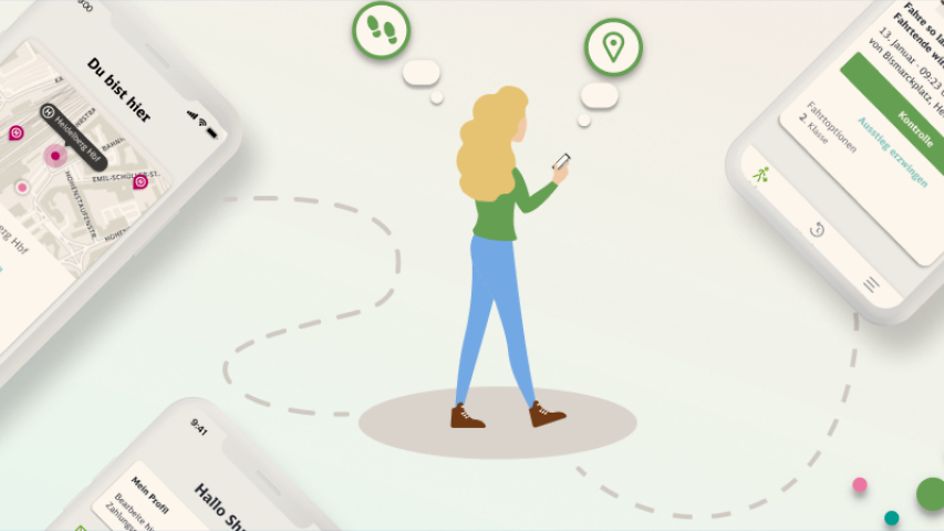Voicebot for demand-responsive services
Article: Book a taxibus automatically thanks to AI – the new hotline for DB Regio Bus
01/2024 – The new voicebot from DB Regio Bus and DB Systel now enables passengers to book their journey on the taxibus service in an automated procedure. This reduces the workload for the call centre and guarantees optimum accessibility for passengers.
Taxibus services are an important component of local mobility for many rural regions. In less densely populated areas, these buses offer a reliable car-free mode of transport for getting people to the doctor or the nearest train station. For example, they keep senior citizens mobile and offer all residents connections to neighbouring communities, closing any gaps between train stations and other transport services. Many rural districts use taxibuses because they offer the sustainability of public transport while at the same time reducing costs for the municipality due to their flexibility, as they are based on the travel requirements of rural residents.
DB Regio Bus currently operates a total of around 500 buses in Germany in "demand-responsive service", as the taxibus is known in the industry jargon. Unlike shared taxis, for example, taxibuses also have stops, routes and a timetable. By making a booking, passengers guarantee that the bus calls at their start and destination stops and ensure that the flexibly structured journeys actually take place. Because if nobody books, the bus doesn't run. This booking procedure should be as quick and easy as possible for passengers so as not to deter anyone from taking up the offer.
Until now, passengers in the administrative districts served by DB Regio Bus have had two options for booking an on-demand journey: firstly, via the "Wohin Du willst" ("Wherever you want") app, which searches for connections and then books and manages journeys. The second option is by telephone using the hotline. DB Regio's "journey planning centre" is there to take such bookings and can help with any questions. Each administrative district has its own phone number for these booking services.
Thanks to a collaboration between DB Systel and DB Regio Bus, there is now another option, namely via voicebot: this service also works by telephone – but is automated. These automated bookings can save time for passengers and reduce the workload for the call centre. For example, in the case of tourists who call the telephone number displayed at a bus stop because they have not installed the app. In practice, anyone seeking uncomplicated mobility has no time to wait in a queue on the phone. For this reason, even short waiting times of a few minutes have led to complaints to the journey planning centre in the past, according to Nadia Panetta, who is responsible for passenger marketing at DB Regio Bus Bayern.
"As DB Regio Bus we pursued a clear strategy for digitalisation and automation. We were strongly convinced of the potential and effectiveness of the voicebot. Given the right use case we decided: Let's do it!"

AI specialists from DB Systel create the voicebot
Automatic telephone booking began with an idea: the original suggestion to automate the journey planning centre was made at a DB Regio Bus hackathon. This approach was an ideal fit for DB Regio's overarching digitalisation strategy. Several departments at DB Regio Bus liked the idea so much that they asked "IT Bus", headed by project manager Asha Joseph-Pattani, to take up the idea and look for practical applications and ways to implement it. This is how the idea of an automated hotline materialised. After an appointment with the AI specialists from the DB Systel venture SEMMI it was clear to DB Regio Bus that it had found the right partner. This is because SEMMI specialises in AI dialogue systems, such as digital avatars at train stations and call centre automation.
In addition to a suitable partner for the implementation, DB Regio Bus also needed a suitable region in which to test the voicebot in practice. Based on criteria such as the relatively low call volume and the booking system used there, the district of Neumarkt in der Oberpfalz was selected as the voicebot pioneer. At the same time, Asha Joseph-Pattani's team drew up a business case to ensure that the project would bring tangible added value for DB Regio Bus. As every AI application initially requires data, DB Regio and DB Systel started by recording all bus stops and connections within the administrative district.
How a voicebot is created
The AI experts at DB Systel first set up a tool for the journey planning centre that collected voice recordings. Call centre personnel were able to use this tool to record thousands of examples in order to train the AI for future use. This resulted in around 50,000 voice files. This is because the AI platform for dialogues must first convert spoken language into text in order to be able to process it – for the booking system, for example. For this specialised task, the AI platform had to "learn" a precisely fitting language model including all specific bus stops, locations and also possible dialects. This means it can always correctly interpret the caller's specific intention. A computer linguist from DB Systel supported the project to ensure that the voice recordings were suitable for the task.
The dialogue design was particularly important for the success and acceptance of the voicebot. The aim here is to make automated dialogue as natural and simple as possible. Together, DB Systel and DB Regio have created the so-called "flows" of dialogue, partly on the basis of real calls to the journey planning centre and partly with the help of DB Systel's computer linguist. This is because the "intro prompt" – the voicebot's initial announcement – is crucial to ensuring that callers understand who they are talking to, what they should say and how the booking works. "An introductory dialogue like this – not too short, not too long – can have a strong influence on user acceptance," says Robert Muras from DB Systel's SEMMI team.
In the subsequent implementation, DB Systel connected the voicebot to the telephone system of the journey planning centre on the one hand and to the booking system for the "Wohin Du willst" journey planning app on the other. This allows the bot to be used wherever the app of the same name is already in use. This is because the voicebot is not a one-way street, but needs interfaces so that it can receive the latest traffic data, for example. Unlike a conventional tape announcement, the finished bot does not speak with pre-recorded audio, but understands speech and speaks itself using AI: for example, it reads out connections from the timetable and saves requested journeys directly in the booking system. This means there is no manual effort involved in these bookings.
The voicebot in practice
The pilot phase started in January 2023 and the voicebot was able to prove itself in practice for the first time in Neumarkt. During this test phase which lasted until June 2023, DB Systel and DB Regio Bus analysed calls and the SEMMI team implemented improvements and updates. "We had our KPIs (notes of success criteria) and we had six months for the pilot," recalls Asha Joseph-Pattani from IT Bus: "Every week we had feedback from the journey planning centre and a new release from DB Systel with improvements. When we saw that the success rate was good enough, we decided together with the administrative district to go into productive operation."
The aim of this test phase was to achieve a success rate of 60 per cent. This quota includes both successful bookings by the bot and successful redirects to the call centre, if these are desired or necessary. A "failure" would be, for example, a transfer to the telephone exchange that is not absolutely necessary or if the caller hangs up during the call. "We soon realised that there were still bugs, which we spent weeks and months fine-tuning to improve the performance rate," recalls Robert Muras from DB Systel.
DB Regio Bus can precisely control the diversions to the automated voicebot system. During the test phase, an average of 80 per cent of calls initially reached the voicebot. The bot's voice recognition and logic work so well that callers could book their journey in a single sentence, such as: "I would like to travel from X to Y tomorrow at eight o'clock." However, the system guides the caller through these points individually to be on the safe side. Customers then receive a text message to confirm their booking.
AI lightens the workload for employees instead of replacing them
At the end of the test phase, the result was that the voicebot had achieved the 60 per cent success rate and handled almost a third of the bookings all by itself. This may not sound like much, but it is expressly desired that a proportion of the calls are forwarded to the call centre. Not all callers want to book a specific trip, some – like many of the region's tourists – are looking initially for advice. In other special cases, a booking with the voicebot may fail from a statistical point of view: If the voice recognition does not understand the caller because the background noise is too loud or, for example, the local dialect becomes a language barrier, the bot automatically forwards the caller to its human colleagues with a message.
On the other hand, the bot can reliably fulfil straightforward travel requests. The voicebot can also answer simple questions from travellers itself (such as "Is my Deutschlandticket valid on the taxibus?"), but in many cases the experts at the journey planning centre are required. For example, for more complicated journeys, such as those with a bicycle, a pushchair, a number of passengers or a change of buses. Even after the test phase, the DB Systel team led by Robert Muras continues to support the solution: "This is a living solution that is constantly being developed iteratively. If we notice any potential for optimisation, our developers are right on it."
It is important to DB Regio that the voicebot does not take the place of employees in the journey planning centre, but rather lightens their workload and creates better accessibility for passengers – potentially around the clock. The voicebot in Neumarkt can make ten calls at the same time and is therefore a relief, especially during peak times. In practice, the bot already handles around 700 calls per week in this comparatively small administrative district. This allows the staff at the journey planning centre to spend more time on passengers' questions and the more complicated bookings and to shorten waiting times.
"Every single call that is answered by the bot counts a lot for us. This is ideal for customers who don't need any help because they know their boarding, alighting and departure times!"

Further administrative districts receive automated order hotlines
Since June 2023, the voicebot in Neumarkt has officially completed the pilot phase and entered productive operation. Now, following this success, further projects will follow: "We have realised that the voicebot is going well and that we can expand it," says Nadia Panetta on the upcoming scaling of the project. "We have deliberately chosen the next administrative districts to be connected not to be small, but to be those that make a big difference." DB Regio and DB Systel are currently preparing to deploy the voicebot in two large Bavarian districts: Deggendorf and Passau. In these two areas, bookings are also made via the "Wohin Du willst" app, which will speed up these follow-up projects considerably. The project team estimates that both projects will only take around four months to launch. "We have a great deal of knowledge that is now reaping benefits for us. Issues such as setting up dialogue paths, defining restrictions and implementing them technically are no longer necessary," says Robert Muras from DB Systel. "That's why we're moving much faster here than in the initial project with the administrative district of Neumarkt."
In the new administrative districts, the names of the stops and their pronunciation in particular need to be integrated and the AI trained accordingly. The tasks for every project also include information and communication: residents are informed about the new function in advance by the administrative district and the employees in the journey planning centre also have to be familiarised with the new processes. However, new administrative districts no longer need a pilot phase, but can be considered productive very soon after initial evaluations. Thanks to the automatic hotline, DB Regio can now advertise that it is available on request 24/7 in future transport tenders from administrative districts. The SEMMI team has also developed a new service based on the experience gained from the project and offers automated telephone services for all Group partners.





